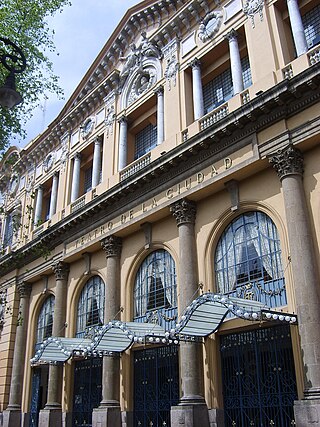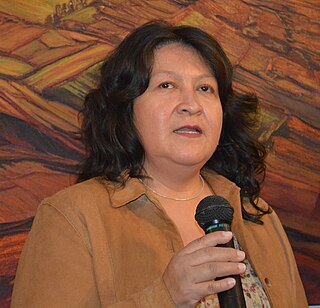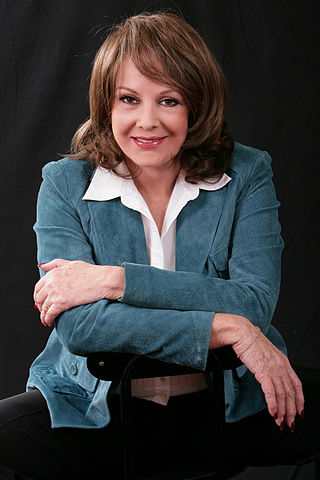

Esther Cardoso is a Cuban film and theater actress, producer, director and educator.


Esther Cardoso is a Cuban film and theater actress, producer, director and educator.
Cardoso was a professor of literature at Central University of Las Villas. [1] In 1977, she went to the Instituto Superior de Arte. [1] She holds a doctorate in Stage Arts. Cardoso was a co-founder of two of Cuba's leading theater companies, Teatro Buendia and Argos Teatro. She has taught at the Instituto Superior de Arte and has given numerous workshops in Cuba, Spain, Argentina, Brazil, England, Germany and Australia. As a director, she has staged important shows, fusing genres and making used of diverse artistic strands.
In 1997, she co-founded Gaia, an arts center in Old Havana, dedicated to promoting creativity in theater, visual arts, filmmaking and music. The center, which also uses performance to further social and educational ends, officially opened on January 1, 2000. [2]
To commemorate Gaia's opening, on the eve of the millennium, she co-directed A Millennium Night's Dream, a fourteen-hour show involving 84 actors, inspired by the mythical conflict between Dionysus (god of pleasure) and Pentheus (lord of reason) involving promenade performances, fire-eating, acrobatics, dance, poetry, and Cuban story-telling.[ citation needed ]
In 2005, Cardoso directed and produced, 'Las cenizas de Ruth', a radical reinterpretation of the biblical story of Ruth. In 2006, she starred in the movies 'Gozar Comer y Partir', [3] and 'La Edad de la Peseta', [4] The following year, she took the leading role in 'La Piel de Elisa,' the Cuban premiere of a play by Carole Frechette. [2]
She currently runs a permanent research workshop on the art of the actor, based at Gaia. [1]

Gaia is an arts centre in Havana, Cuba, set up on January 1, 2000 as a not-for-profit collaboration between Cuban and international artists.
Gilberto Ruíz Valdéz is a Cuban-American artist.
Adriano Buergo, is a Cuban artist specializing in painting, drawing and installations.
Sandra Amelia Ceballos Obaya is a Cuban artist.
Hilda Aurora Vidal Valdés is a Cuban artist, specializing in painting, drawing, design, sculpture, collage, artistic tapestry, and papier mache.

Rita Aurelia Fulcida Montaner y Facenda, known as Rita Montaner, was a Cuban singer, pianist and actress. In Cuban parlance, she was a vedette, and was well known in Mexico City, Paris, Miami and New York, where she performed, filmed and recorded on numerous occasions. She was one of Cuba's most popular artists between the late 1920s and 1950s, renowned as Rita de Cuba. Though classically trained as a soprano for zarzuelas, her mark was made as a singer of Afro-Cuban salon songs including "The Peanut Vendor" and "Siboney".
Cuban musical theatre has its own distinctive style and history. From the 18th century to modern times, popular theatrical performances included music and often dance as well. Many composers and musicians had their careers launched in the theatres, and many compositions got their first airing on the stage. In addition to staging some European operas and operettas, Cuban composers gradually developed ideas which better suited their creole audience. Characters on stages began to include elements from Cuban life, and the music began to reflect a fusion between African and European contributions.

The Sauto Theater opened in 1863 in Matanzas, Cuba, and has since then been a proud symbol of the city. The U-shaped 775-seat theatre is almost entirely covered with wood-panelling. It has three balconies, and its floor can be raised to convert the auditorium into a ballroom. The original theater curtain is a painting of the Puente de la Concordia over the Yumurí River. The lobby is graced by Carrara marble statues of Greek goddesses and the main hall ceiling bears paintings of the muses.

The Teatro de la Ciudad was built as the Teatro Esperanza Iris in 1918 and is now one of Mexico City’s public venues for cultural events. The theater is located in the historic center of Mexico City on Donceles Street 36.

Carlos Enrique Prado is a contemporary Cuban artist. He has worked in various artistic media such as sculpture, ceramics, drawing, digital art, performance, installations and interventions. Between 2002 and 2012, he was a professor at ISA University of Arts of Cuba, where he was also the head of the sculpture program. He currently lives and works in Miami, Florida. He teaches ceramics and sculpture at the University of Miami, Coral Gables, Florida. He recently completed a major public sculpture, the Ronald Reagan Equestrian Monument, located in Tropical Park, Miami, commissioned by Miami-Dade County's Art in Public Places program.
Flores Chaviano is an accomplished Cuban composer, guitarist, professor and orchestral conductor that has achieved great international recognition.
The following is a timeline of the history of Havana, Cuba.
Leandro Soto was a Cuban-American multidisciplinary visual/installation and performance artist. He was also a set and costume designer for theater and film. Soto studied at Escuela Nacional de Arte National Art Schools (Cuba) and Instituto Superior de Arte, University of Havana. As an educator he taught and lectured at various Higher Education institutions in the U.S. and abroad. Soto also founded a creative workshop, El Tesoro de Tamulte, in Tabasco, Mexico, from which professional artists emerged.

Angelica Carrasco is a Mexican graphic artist who is a pioneer of large scale printmaking in the country. Her work often is related to violence and classified as “abstract neo-expressionism.” Much of her career has been dedicated to teaching and the promotion of the arts, especially the graphic arts and has been recognized with membership in the Salón de la Plástica Mexicana and the Sistema Nacional de Creadores de Arte.
Magali Alabau is a Cuban-American poet, theater director, and actor. Born in Cienfuegos, Cuba, she has lived in New York since 1966. She co-founded the Spanish-English ensemble Teatro Dúo/Duo Theatre with Manuel Martín, Jr. and the lesbian theater Medusa's Revenge with Ana María Simo. She began writing poetry after retiring from theater, and published eight books between 1986 and 2015.

Esther Seligson was a Mexican writer, poet, translator, and historian. She was an academic, with a wide range of interests including art, cultural history, Jewish philosophy, mythology, religion and theater. She published books, poems, short stories and translations. She won the Xavier Villaurrutia Prize and the Magda Donato Award for her literary contributions.

Wilma Alba Cal is a Cuban composer of contemporary classical music. Her work has been recognized in several competitions in Cuba organized by National Union of Writers and Artists of Cuba (UNEAC), Instituto Superior de Arte, Asociación Hermanos Saíz and Instituto Cubano de la Música. Her catalog includes chamber, choir, electroacoustic and orchestral music, in addition to soundtracks for theatre and audiovisual works.
Alfredo Diez Nieto was a Cuban composer, conductor, and professor. He taught composition at Instituto Musical Kohly, the Amadeo Roldán Conservatory, the National Art School, and the Instituto Superior de Arte in Havana. He founded and conducted the Orquesta Popular de Conciertos. Diez Nieto composed orchestral works including three symphonies and chamber music for various instruments, using and transforming elements from Cuban folk music.

Isabel Moreno Pérez is a Cuban actress.

María Isabel Díaz Lago is a Cuban actress. A graduate of the Instituto Superior de Arte, her first film role was in Una novia para David. She became the first Cuban "Almodóvar girl", appearing in the 2006 film Volver. On the small screen, she is best known for her role as Soledad "Sole" Núñez Hurtado on Locked Up. She has resided in Spain since 1996.